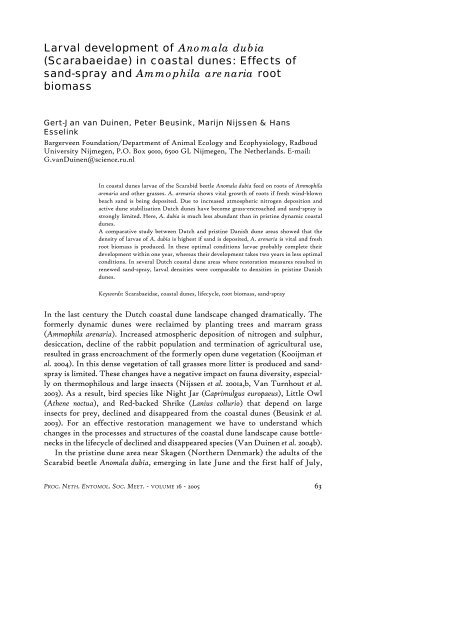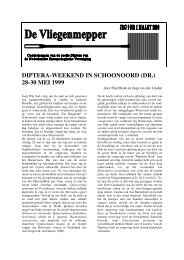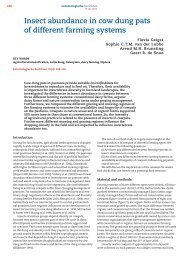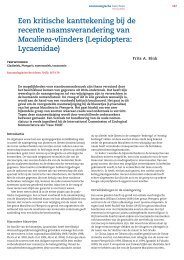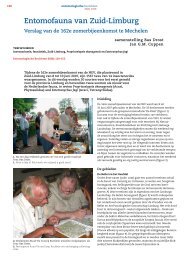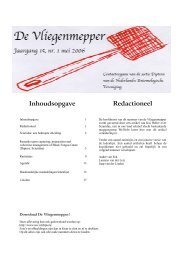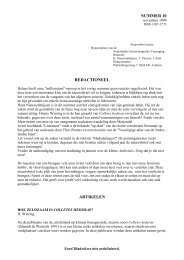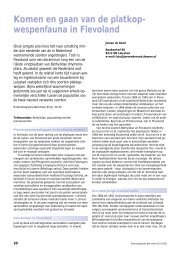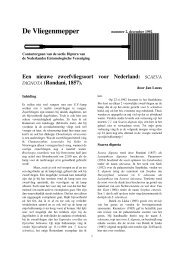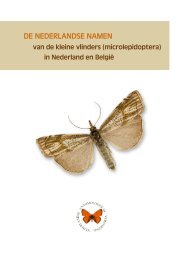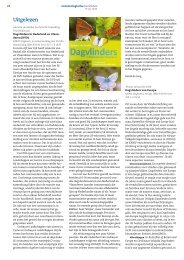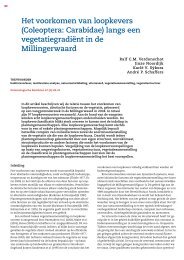Larval development of Anomala dubia (Scarabaeidae) in coastal ...
Larval development of Anomala dubia (Scarabaeidae) in coastal ...
Larval development of Anomala dubia (Scarabaeidae) in coastal ...
Create successful ePaper yourself
Turn your PDF publications into a flip-book with our unique Google optimized e-Paper software.
<strong>Larval</strong> <strong>development</strong> <strong>of</strong> <strong>Anomala</strong> <strong>dubia</strong><br />
(<strong>Scarabaeidae</strong>) <strong>in</strong> <strong>coastal</strong> dunes: Effects <strong>of</strong><br />
sand-spray and Ammophila arenaria root<br />
biomass<br />
Gert-Jan van Du<strong>in</strong>en, Peter Beus<strong>in</strong>k, Marijn Nijssen & Hans<br />
Essel<strong>in</strong>k<br />
Bargerveen Foundation/Department <strong>of</strong> Animal Ecology and Ecophysiology, Radboud<br />
University Nijmegen, P.O. Box 9010, 6500 GL Nijmegen, The Netherlands. E-mail:<br />
G.vanDu<strong>in</strong>en@science.ru.nl<br />
In <strong>coastal</strong> dunes larvae <strong>of</strong> the Scarabid beetle <strong>Anomala</strong> <strong>dubia</strong> feed on roots <strong>of</strong> Ammophila<br />
arenaria and other grasses. A. arenaria shows vital growth <strong>of</strong> roots if fresh w<strong>in</strong>d-blown<br />
beach sand is be<strong>in</strong>g deposited. Due to <strong>in</strong>creased atmospheric nitrogen deposition and<br />
active dune stabilisation Dutch dunes have become grass-encroached and sand-spray is<br />
strongly limited. Here, A. <strong>dubia</strong> is much less abundant than <strong>in</strong> prist<strong>in</strong>e dynamic <strong>coastal</strong><br />
dunes.<br />
A comparative study between Dutch and prist<strong>in</strong>e Danish dune areas showed that the<br />
density <strong>of</strong> larvae <strong>of</strong> A. <strong>dubia</strong> is highest if sand is deposited, A. arenaria is vital and fresh<br />
root biomass is produced. In these optimal conditions larvae probably complete their<br />
<strong>development</strong> with<strong>in</strong> one year, whereas their <strong>development</strong> takes two years <strong>in</strong> less optimal<br />
conditions. In several Dutch <strong>coastal</strong> dune areas where restoration measures resulted <strong>in</strong><br />
renewed sand-spray, larval densities were comparable to densities <strong>in</strong> prist<strong>in</strong>e Danish<br />
dunes.<br />
Keywords: <strong>Scarabaeidae</strong>, <strong>coastal</strong> dunes, lifecycle, root biomass, sand-spray<br />
In the last century the Dutch <strong>coastal</strong> dune landscape changed dramatically. The<br />
formerly dynamic dunes were reclaimed by plant<strong>in</strong>g trees and marram grass<br />
(Ammophila arenaria). Increased atmospheric deposition <strong>of</strong> nitrogen and sulphur,<br />
desiccation, decl<strong>in</strong>e <strong>of</strong> the rabbit population and term<strong>in</strong>ation <strong>of</strong> agricultural use,<br />
resulted <strong>in</strong> grass encroachment <strong>of</strong> the formerly open dune vegetation (Kooijman et<br />
al. 2004). In this dense vegetation <strong>of</strong> tall grasses more litter is produced and sandspray<br />
is limited. These changes have a negative impact on fauna diversity, especially<br />
on thermophilous and large <strong>in</strong>sects (Nijssen et al. 2001a,b, Van Turnhout et al.<br />
2003). As a result, bird species like Night Jar (Caprimulgus europaeus), Little Owl<br />
(Athene noctua), and Red-backed Shrike (Lanius collurio) that depend on large<br />
<strong>in</strong>sects for prey, decl<strong>in</strong>ed and disappeared from the <strong>coastal</strong> dunes (Beus<strong>in</strong>k et al.<br />
2003). For an effective restoration management we have to understand which<br />
changes <strong>in</strong> the processes and structures <strong>of</strong> the <strong>coastal</strong> dune landscape cause bottlenecks<br />
<strong>in</strong> the lifecycle <strong>of</strong> decl<strong>in</strong>ed and disappeared species (Van Du<strong>in</strong>en et al. 2004b).<br />
In the prist<strong>in</strong>e dune area near Skagen (Northern Denmark) the adults <strong>of</strong> the<br />
Scarabid beetle <strong>Anomala</strong> <strong>dubia</strong>, emerg<strong>in</strong>g <strong>in</strong> late June and the first half <strong>of</strong> July,<br />
PROC. NETH. ENTOMOL. SOC. MEET. - VOLUME 16 - 2005 63
CONSERVATION BIOLOGY<br />
are the ma<strong>in</strong> prey species <strong>in</strong> the nestl<strong>in</strong>g diet <strong>of</strong> Red-backed Shrikes <strong>in</strong> the<br />
dynamic foredunes. In the diet <strong>of</strong> the last Red-backed Shrikes <strong>in</strong> the Dutch<br />
<strong>coastal</strong> dunes scarabid beetles were almost lack<strong>in</strong>g (Beus<strong>in</strong>k et al. 2003, Van<br />
Du<strong>in</strong>en et al. 2004a). Although data are not available and densities <strong>of</strong> Scarabid<br />
beetles can fluctuate considerably, the abundance <strong>of</strong> A. <strong>dubia</strong> and other Scarabid<br />
beetles, like Phyllopertha horticola, Melolontha hippocastani, and Polyphylla fullo, is<br />
generally decreased <strong>in</strong> the Dutch <strong>coastal</strong> dunes. Accord<strong>in</strong>g to literature references<br />
these species were common <strong>in</strong> the Dutch dunes <strong>in</strong> the first half <strong>of</strong> the last<br />
century (e.g. Everts 1898-1922, Prud’homme van Re<strong>in</strong>e 1950, Van Heerdt &<br />
Mörzer Bruyns 1960).<br />
The larvae <strong>of</strong> these Scarabid beetles eat plant roots (Koch 1989). In the Danish<br />
<strong>coastal</strong> dunes A. <strong>dubia</strong> is very abundant <strong>in</strong> the dynamic dunes adjacent to the<br />
beach, where A. arenaria and Leymus arenarius are grow<strong>in</strong>g (Beus<strong>in</strong>k et al. 2003).<br />
Research has shown that due to root pathogens growth conditions for these grasses<br />
deteriorate (Van der Putten et al. 1988, Greipsson & El-Mayas 2002). However,<br />
if freshly w<strong>in</strong>d-blown beach sand is deposited A. arenaria plants have five to ten<br />
times more vital root biomass than plants grow<strong>in</strong>g <strong>in</strong> stable dunes, where most<br />
roots degenerate and only bark rema<strong>in</strong>s (Willis 1989, De Rooij-Van der Goes et al.<br />
1995). Therefore, we hypothesise that sand-spray is an important factor <strong>in</strong> the production<br />
<strong>of</strong> sufficient high quality food for A. <strong>dubia</strong> larvae and that the decl<strong>in</strong>e <strong>of</strong><br />
sand-spray <strong>in</strong> Dutch <strong>coastal</strong> dunes have caused decl<strong>in</strong>e <strong>of</strong> A. <strong>dubia</strong>.<br />
To study whether the <strong>development</strong> and density <strong>of</strong> A. <strong>dubia</strong> larvae are <strong>in</strong>deed<br />
affected by sand-spray and root biomass, a comparative field study was started<br />
<strong>in</strong> Dutch and Danish <strong>coastal</strong> dune areas. The density <strong>of</strong> A. <strong>dubia</strong> larvae was<br />
assessed <strong>in</strong> A. arenaria stands, differ<strong>in</strong>g <strong>in</strong> sand-spray, vegetation density and<br />
root biomass. The Dutch sampl<strong>in</strong>g sites <strong>in</strong>cluded sites <strong>in</strong> which sand-spray still<br />
# larvae<br />
20<br />
18<br />
16<br />
14<br />
12<br />
10<br />
8<br />
6<br />
4<br />
2<br />
0<br />
1<br />
1 1,5 2 2,5 3 3,5 4 4,5 5<br />
head capsule width (mm)<br />
Figure 1. Head capsule width <strong>of</strong> the three larval stages <strong>of</strong> <strong>Anomala</strong> <strong>dubia</strong> measured on 93<br />
larvae collected <strong>in</strong> Dutch and Danish dunes. Arrows <strong>in</strong>dicate the head capsule width <strong>of</strong><br />
the larval stages accord<strong>in</strong>g to Klausnitzer & Krell (1996).<br />
64<br />
2 3
occurred and <strong>in</strong> which sand-spray was reactivated. In the prist<strong>in</strong>e dune area near<br />
Skagen dynamic, less dynamic and stable dunes were sampled, serv<strong>in</strong>g as a reference<br />
for the Dutch situation.<br />
MATERIAL AND METHODS<br />
<strong>Anomala</strong> <strong>dubia</strong> larvae were collected by excavat<strong>in</strong>g 1 m 2 to a depth <strong>of</strong> 1 m. The<br />
sand was spread and the larvae were collected from the spread sand. <strong>Larval</strong><br />
stages were determ<strong>in</strong>ed by measur<strong>in</strong>g head capsule width. Twenty-n<strong>in</strong>e sites <strong>in</strong><br />
eight Dutch <strong>coastal</strong> dune areas were sampled between the end <strong>of</strong> October and<br />
half December 2003 (see Van Du<strong>in</strong>en et al. 2004a) and November 2004. The<br />
Dutch sampl<strong>in</strong>g sites were classified <strong>in</strong> categories accord<strong>in</strong>g to the <strong>in</strong>tensity <strong>of</strong><br />
sand-spray and the succession stage and root biomass <strong>of</strong> A. arenaria. In the prist<strong>in</strong>e<br />
<strong>coastal</strong> dunes near Skagen, Denmark, 3 sites were sampled <strong>in</strong> September<br />
2003: one site <strong>in</strong> a dynamic dune, one <strong>in</strong> a less dynamic dune, and one <strong>in</strong> a stable<br />
dune. In June and July 2004 five sites <strong>of</strong> each <strong>of</strong> these three categories were sampled<br />
near Skagen and fresh weight <strong>of</strong> the root biomass was measured.<br />
RESULTS<br />
G.-J. VAN DUINEN, P. BEUSINK, M. NIJSSEN & H. ESSELINK<br />
At the sampl<strong>in</strong>g sites only second- and third-stage larvae (L2 and L3) and pupae<br />
<strong>of</strong> A. <strong>dubia</strong> were found. Larvae were ma<strong>in</strong>ly found between 30 and 60 cm depth<br />
and never at a depth <strong>of</strong> more than 80 cm. The ranges <strong>of</strong> the head capsule width<br />
<strong>of</strong> the larvae are presented <strong>in</strong> Figure 1. The head capsule width <strong>of</strong> first stage larvae<br />
was measured on larvae collected by means <strong>of</strong> rear<strong>in</strong>g eggs deposited <strong>in</strong><br />
sand-filled pots by collected females. The head capsule width showed clear clusters<br />
for each <strong>of</strong> the three larval stages. For the L2 and L3 the size ranges appeared<br />
to differ from the ranges given by Klausnitzer & Krell (1996).<br />
In September 2003 the highest number <strong>of</strong> A. <strong>dubia</strong> larvae were found <strong>in</strong> the<br />
most dynamic Danish site (Fig. 2a). Only <strong>in</strong> the stable dune site a L2-larva was<br />
found. In June/July 2004 almost no larvae and pupae were found <strong>in</strong> the most<br />
dynamic sites, whereas several pupae and L2 and L3-larvae were found <strong>in</strong> the less<br />
dynamic sites (Fig. 2b). The average root biomass was highest <strong>in</strong> the dynamic<br />
dunes, but variation was high (ANOVA: P=0.13; Fig. 2c).<br />
In 17 <strong>of</strong> the 29 Dutch sites larvae were found. In n<strong>in</strong>e <strong>of</strong> them 5-8 larvae per<br />
m 3 were found. These numbers are between the 4 and 9 larvae per m 3 found <strong>in</strong><br />
the less dynamic and dynamic Danish dunes, respectively, <strong>in</strong> September 2003.<br />
These relatively high densities were found <strong>in</strong> still active dunes (De Bl<strong>in</strong>k and<br />
Buizerdvlak), as well as <strong>in</strong> areas that have been reactivated (De Kerf, Kraansvlak<br />
and a filled-up <strong>in</strong>filtration lake <strong>in</strong> the Helmdu<strong>in</strong>en area).<br />
In vital expand<strong>in</strong>g A. arenaria stands the average density <strong>of</strong> larvae was more<br />
than three times higher than <strong>in</strong> the other succession stages (ANOVA: P=0.02;<br />
Fig. 3a). In sites with moderate or much sand-spray more larvae were found than<br />
<strong>in</strong> sites with little or no sand-spray (ANOVA: P=0.19; Fig. 3b). In these stands<br />
65
CONSERVATION BIOLOGY<br />
relatively much fresh root biomass is produced. The density <strong>of</strong> larvae was highest<br />
if a high and vital root mass was present (ANOVA: P=0.08; Fig. 3d). In sites<br />
with a litter layer the density <strong>of</strong> larvae was significantly lower than <strong>in</strong> sites with<br />
open sand (T-test: P=0.02; Fig. 3c). The highest densities <strong>of</strong> larvae were found<br />
when the vegetation cover was 30-50%, although the number <strong>of</strong> sampl<strong>in</strong>g sites<br />
with low or high vegetation cover were very small and variation <strong>in</strong> density was<br />
high (Fig. 4).<br />
root biomass (gram/m3)<br />
# larvae/m3<br />
# larvae/m3<br />
10<br />
10<br />
8<br />
6<br />
4<br />
2<br />
0<br />
8<br />
6<br />
4<br />
2<br />
0<br />
250<br />
200<br />
150<br />
100<br />
50<br />
0<br />
September 2003<br />
Dynamic Less<br />
dynamic<br />
June/July 2004<br />
Dynamic Less<br />
dynamic<br />
Dynamic Less<br />
dynamic<br />
66<br />
L2<br />
L3<br />
Stable<br />
L2<br />
L3<br />
Pupae<br />
Stable<br />
Stable<br />
Figure 2. Number <strong>of</strong> larvae collected <strong>in</strong> a.) September 2003 (n=1), b.) and June/July 2004<br />
(n=5), and c) average fresh weight <strong>of</strong> root biomass (±SE; n=5) <strong>in</strong> dynamic, less dynamic<br />
and stable dunes near Skagen.<br />
c<br />
a<br />
b
DISCUSSION<br />
G.-J. VAN DUINEN, P. BEUSINK, M. NIJSSEN & H. ESSELINK<br />
The density <strong>of</strong> A. <strong>dubia</strong> larvae is highest <strong>in</strong> the sites with substantial sand-spray<br />
and where A. arenaria is vital and produces new shoots and a high root biomass.<br />
Most larvae live at 30-60 cm depth. At this depth most vital root biomass is present<br />
(Willis 1989). Few or no larvae are present <strong>in</strong> stabilised dunes, with a dense<br />
a<br />
# larvae/m3<br />
c<br />
# larvae/m3<br />
3<br />
2<br />
1<br />
0<br />
Marram stage<br />
n= 4 2 6 14<br />
4<br />
3<br />
2<br />
1<br />
0<br />
pioneer relict stable expand<strong>in</strong>g<br />
Litter<br />
n= 23 6<br />
*<br />
open sand litter<br />
*<br />
67<br />
d<br />
b<br />
# larvae/m3<br />
# larvae/m3<br />
4<br />
3<br />
2<br />
1<br />
0<br />
Sand-spray<br />
n= 2 4 11 12<br />
4<br />
3<br />
2<br />
1<br />
0<br />
none little moderate much<br />
Root biomass<br />
n= 6 15 8<br />
none/old little vital<br />
Figure 3. Average numbers (±SE) <strong>of</strong> larvae/m 3 <strong>in</strong> the dist<strong>in</strong>guished categories <strong>of</strong> site conditions<br />
<strong>in</strong> Dutch <strong>coastal</strong> dunes. * <strong>in</strong>dicates P
CONSERVATION BIOLOGY<br />
vegetation and no or little sand-spray. In pioneer stages <strong>of</strong> A. arenaria vegetation<br />
with still a lot <strong>of</strong> open sand and a low vegetation cover the larval density is generally<br />
low. As there are few plants grow<strong>in</strong>g <strong>in</strong> these pioneer situations, root biomass<br />
is probably still too low to provide a sufficient amount <strong>of</strong> food for A. <strong>dubia</strong><br />
larvae, or plants were not yet present at the sampl<strong>in</strong>g sites at the time <strong>of</strong> egg deposition.<br />
At some <strong>of</strong> the sampl<strong>in</strong>g sites no or few larvae were found, although the conditions<br />
seemed to be similar to sites where a high density <strong>of</strong> larvae was found.<br />
On the other hand, several larvae were found <strong>in</strong> some <strong>of</strong> the sampl<strong>in</strong>g sites <strong>in</strong><br />
fairly stable dunes, with a litter or moss layer. These ‘exceptions’ might be due<br />
to the population size <strong>of</strong> A. <strong>dubia</strong>, the total area <strong>of</strong> suitable biotope and (historical)<br />
<strong>development</strong>s <strong>in</strong> the area. In the Dutch <strong>coastal</strong> dunes suitable conditions for<br />
A. <strong>dubia</strong> are generally limited to relatively very small areas, surrounded by large<br />
areas with grass and moss encroached vegetation. Here, suitable sites might be<br />
‘missed’ by A. <strong>dubia</strong>, as the population size is generally small. Contrary to the<br />
Dutch situation, <strong>in</strong> the prist<strong>in</strong>e Danish dune area suitable conditions are present<br />
<strong>in</strong> a very large area along the coast. Here, a larger (meta-)population is present<br />
and there might be a higher chance that eggs are deposited <strong>in</strong> sites adjacent to<br />
the more optimal area. Data on this aspect are not available. Moreover, the number<br />
<strong>of</strong> sites sampled <strong>in</strong> this study is still relatively small, especially <strong>in</strong> the less<br />
optimal sites, whereas the variation <strong>in</strong> the density <strong>of</strong> larvae is fairly large.<br />
Furthermore, the nutritional value <strong>of</strong> the root biomass, one <strong>of</strong> the most important<br />
characteristics <strong>of</strong> the larval biotope, has not yet been analysed, but was<br />
roughly classified based on the appearance <strong>of</strong> the roots.<br />
Rittershaus (1927) studied the life-cycle <strong>of</strong> A. <strong>dubia</strong> <strong>in</strong> an <strong>in</strong>land situation. The<br />
larvae went through the three larval stages <strong>in</strong> two years. The pupal stage lasted<br />
30-40 days and the adults emerged <strong>in</strong> the end <strong>of</strong> June and the first half <strong>of</strong> July.<br />
Accord<strong>in</strong>g to Medvedev (<strong>in</strong>: Allenspach 1970) larval <strong>development</strong> can be completed<br />
<strong>in</strong> one year. In the most dynamic prist<strong>in</strong>e dune sites very few larvae were<br />
found <strong>in</strong> June/July 2004 (Fig. 2b). Probably, almost all larvae are able to complete<br />
their <strong>development</strong> <strong>in</strong> one year <strong>in</strong> this optimal situation and almost all <strong>in</strong>dividuals<br />
were emerged before we took the summer samples. In the preced<strong>in</strong>g<br />
autumn all larvae found <strong>in</strong> the dynamic dune site were already <strong>in</strong> their third<br />
stage. Then, only one second-stage larva was found <strong>in</strong> the (less optimal) stable<br />
dune site (Fig. 2a). Overall, <strong>in</strong> the Dutch sites sampled <strong>in</strong> late autumn 2003 the<br />
relative number <strong>of</strong> second-stage larvae was higher than <strong>in</strong> the Danish sites sampled<br />
<strong>in</strong> September. This might be due to a slower larval <strong>development</strong> <strong>in</strong> the<br />
Dutch dunes, because <strong>of</strong> less optimal conditions. Additional samples will be<br />
taken to better understand the larval <strong>development</strong> rate <strong>in</strong> optimal and marg<strong>in</strong>al<br />
conditions. If the larval <strong>development</strong> rate is <strong>in</strong>deed lower if A. arenaria produces<br />
less root biomass and/or roots hav<strong>in</strong>g a lower nutritional value for A. <strong>dubia</strong>, this<br />
will cause a considerably lower abundance <strong>of</strong> adult beetles above ground.<br />
68
G.-J. VAN DUINEN, P. BEUSINK, M. NIJSSEN & H. ESSELINK<br />
The density <strong>of</strong> larvae <strong>in</strong> sites with a litter layer is much lower than <strong>in</strong> open<br />
sandy sites (Fig. 3c). Open sand might be important for the adults to dig <strong>in</strong>to the<br />
sand to deposit their eggs and a litter layer might hamper egg deposition. A litter<br />
layer – as well as a dense vegetation cover – might also subdue temperature<br />
fluctuations <strong>in</strong> the sandy soil, even at several decimetres below the surface (Van<br />
Du<strong>in</strong>en et al. 2004a). Changes <strong>in</strong> the microclimate might <strong>in</strong>fluence the larval<br />
<strong>development</strong> rate, as was shown for the dung beetle Typhaeus typhoeus<br />
(Brussaard 1983).<br />
In several areas that have been reactivated by means <strong>of</strong> restoration measures<br />
the density <strong>of</strong> larvae was comparable to those <strong>in</strong> prist<strong>in</strong>e <strong>coastal</strong> dunes. Other<br />
herbivores on roots and shoots, like larvae <strong>of</strong> Elateridae, Curculionidae,<br />
Noctuidae and Homoptera are probably affected by plant biomass production<br />
and quality <strong>in</strong> the same way as A. <strong>dubia</strong>. Thus, reactivation <strong>of</strong> sand-spray is a<br />
promis<strong>in</strong>g restoration measure <strong>in</strong> <strong>coastal</strong> dunes.<br />
Acknowledgements This study was f<strong>in</strong>anced by Waterleid<strong>in</strong>gbedrijf Amsterdam,<br />
Du<strong>in</strong>waterbedrijf Zuid-Holland, Prov<strong>in</strong>ciaal Waterleid<strong>in</strong>gbedrijf Noord-Holland and<br />
Staatsbosbeheer. The Miljøm<strong>in</strong>isteriet and Nordjyllands Statsskovdistrikt gave permission<br />
to do the research near Skagen. Marten Geertsma, Jan Kuper, Theo Peeters, Jeroen<br />
Bosveld and Bart Wouters are acknowledged for their help dur<strong>in</strong>g the field work.<br />
REFERENCES<br />
Allenspach, V. 1970. Insecta Helvetica Catalogus 2 – Coleoptera: Scarabidae, Lucanidae.<br />
Schweizerischen Entomologischen Gesellschaft, Lausanne, Switzerland.<br />
Beus<strong>in</strong>k, P., Nijssen, M., Van Du<strong>in</strong>en, G.A. & Essel<strong>in</strong>k, H. 2003. Broed- en voedselecologie<br />
van Grauwe Klauwieren <strong>in</strong> <strong>in</strong>tacte kustdu<strong>in</strong>en bij Skagen, Denemarken. Referentieonderzoek<br />
voor optimalisatie van beheers- en herstelmaatregelen voor fauna <strong>in</strong> Nederlandse<br />
du<strong>in</strong>en. Rapport Sicht<strong>in</strong>g Bargerveen, Nijmegen, The Netherlands.<br />
Brussaard, L. 1983. Reproductive behaviour and <strong>development</strong> <strong>of</strong> the dung beetle Typhaeus<br />
typhoeus (Coleoptera, Geotrupidae). Tijdschrift voor Entomologie 126: 203-231.<br />
De Rooij-Van der Goes, P.C.E.M., Van der Putten, W.H. & Peters, B.A.M. 1995. Effects<br />
<strong>of</strong> sand deposition on the <strong>in</strong>teraction between Ammophila arenaria, plant-parasitic<br />
nematodes, and pathogenic fungi. Canadian Journal <strong>of</strong> Botany 73: 1141-1150.<br />
Everts, E.J.G. 1898 (deel I) –1903 (deel II) – 1922 (deel III). Coleoptera Neerlandica: de<br />
schildvleugelige <strong>in</strong>secten van Nederland en het aangrenzende gebied. Uitgeverij Nijh<strong>of</strong>f, ’s<br />
Gravenhage, The Netherlands.<br />
Greipsson, S. & El-Mayas, H. 2002. Synergistic effect <strong>of</strong> soil pathogenic fungi and nematodes<br />
reduc<strong>in</strong>g bioprotection <strong>of</strong> Arbuscular mycorrhizal fungi on the grass Leymus<br />
arenarius. BioControl 47: 715-727.<br />
Klausnitzer, B. & Krell, F.-T. 1996. Familie: <strong>Scarabaeidae</strong>. In: B. Klausnitzer (Ed.), Die<br />
Larven der Käfer Mitteleuropas 3, pp. 37-89. Gustav Fischer, Jena, Germany.<br />
Koch, K. 1989. <strong>Scarabaeidae</strong>. In: K. Koch, Die Käfer Mitteleuropas: Ökologie, Band E2, pp.<br />
348-381. Goecke & Evers, Krefeld, Germany.<br />
Kooijman, A.M., Grootjans, A.P., Van Til, M. & Van der Spek, E. 2004. Aantast<strong>in</strong>g <strong>in</strong><br />
droge en natte du<strong>in</strong>en: dezelfde oorzaken, verschillende gevolgen? In: Van Du<strong>in</strong>en,<br />
69
CONSERVATION BIOLOGY<br />
G.A. et al. (Eds.), Duurzaam natuurherstel voor behoud van biodiversiteit, 15 jaar herstelmaatregelen<br />
<strong>in</strong> het kader van het Overlev<strong>in</strong>gsplan Bos en Natuur, pp. 171-187.<br />
Expertisecentrum LNV rapport nr. 2004/305, The Netherlands.<br />
Nijssen, M., Alders, K., Van der Smissen, N. & Essel<strong>in</strong>k, H. 2001a. Effects <strong>of</strong> grassencroachment<br />
and graz<strong>in</strong>g management on carabid assemblages <strong>of</strong> dry dune grasslands.<br />
Proceed<strong>in</strong>gs <strong>of</strong> Experimental and Applied Entomology, NEV Amsterdam 12: 113-120.<br />
Nijssen M., Essel<strong>in</strong>k H., Van Du<strong>in</strong>en G.J., Geertsma M., Jansen J., Kuper J. 2001b.<br />
Gevolgen van vermest<strong>in</strong>g, verzur<strong>in</strong>g en verdrog<strong>in</strong>g en van beheersmaatregelen op de fauna,<br />
vegetatie en abiotiek van du<strong>in</strong>gebieden op Ameland en Terschell<strong>in</strong>g. Rapport Sticht<strong>in</strong>g<br />
Bargerveen, Nijmegen, The Netherlands.<br />
Prud’homme van Re<strong>in</strong>e, W.J. 1950. Wat v<strong>in</strong>d ik <strong>in</strong> de du<strong>in</strong>en? W.J. Thieme & Cie,<br />
Zutphen, The Netherlands.<br />
Rittershaus, K. 1927. Studien zur Morphologie und Biologie von Phyllopertha horticola L.<br />
und <strong>Anomala</strong> aenea Geer. (Coleopt.). Z. F. Morphol. u. Ökol. d. Tiere 8: 271-408.<br />
Van der Putten, W.H., Van Dijk, C. & Troelstra, S.R. 1988. Biotic soil factors affect<strong>in</strong>g<br />
the growth and <strong>development</strong> <strong>of</strong> Ammophila arenaria. Oecologia 76: 313-320.<br />
Van Du<strong>in</strong>en, G.A., Beus<strong>in</strong>k, P., Nijssen, M. & Essel<strong>in</strong>k, H. 2004a. Breed<strong>in</strong>g and food ecology<br />
<strong>of</strong> Red-backed Shrikes <strong>in</strong> <strong>in</strong>tact <strong>coastal</strong> dunes – The beetle <strong>Anomala</strong> <strong>dubia</strong> as a l<strong>in</strong>k <strong>in</strong><br />
the foodweb. Sticht<strong>in</strong>g Bargerveen, Nijmegen, The Netherlands.<br />
Van Du<strong>in</strong>en, G.A., Van Kleef, H.H., Nijssen, M., Van Turnhout, C.A.M., Verberk,<br />
W.C.E.P., Holtland, J. & Essel<strong>in</strong>k, H. 2004b. Schaal en <strong>in</strong>tensiteit van herstelmaatregelen:<br />
Hoe reageert de fauna? In: G.A. van Du<strong>in</strong>en et al. (Eds.), Duurzaam natuurherstel<br />
voor behoud van biodiversiteit – 15 jaar herstelmaatregelen <strong>in</strong> het kader van het overlev<strong>in</strong>gsplan<br />
bos en natuur, pp. 189-240. Rapport EC-LNV nr. 2004/305, Ede, The<br />
Netherlands.<br />
Van Heerdt P.F. & Mörzer Bruyns, M.F. 1960. A biocenological <strong>in</strong>vestigation <strong>in</strong> the yellow<br />
dune region <strong>of</strong> Terschell<strong>in</strong>g. Tijdschrift voor Entomologie 103: 225-275.<br />
Van Turnhout, C.A.M., Stuijfzand, S.C., Nijssen, M.N. & Essel<strong>in</strong>k, H. 2003. Gevolgen<br />
van verzur<strong>in</strong>g, vermest<strong>in</strong>g en verdrog<strong>in</strong>g en <strong>in</strong>vloed van herstelbeheer op de du<strong>in</strong>fauna.<br />
Rapport 2003/153, Expertisecentrum LNV, Ede, The Netherlands.<br />
Willis, A.J. 1989. Sand dunes as ecological systems. In: Coastal sand dunes, proceed<strong>in</strong>gs <strong>of</strong><br />
the Symposium held at 22, 24 George Street, Ed<strong>in</strong>burgh, 17-19 May 1989.<br />
70


